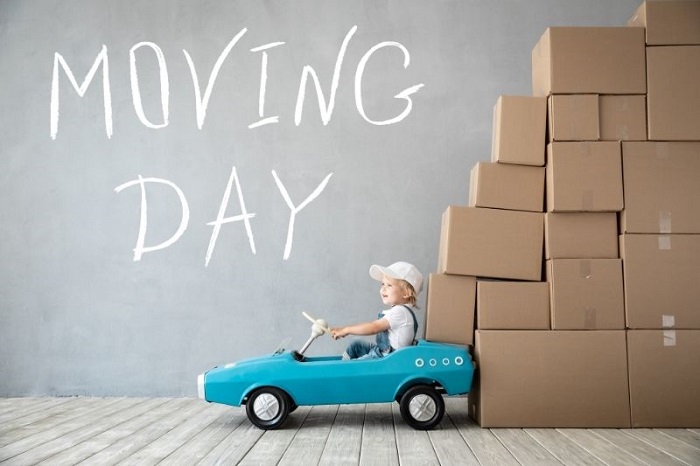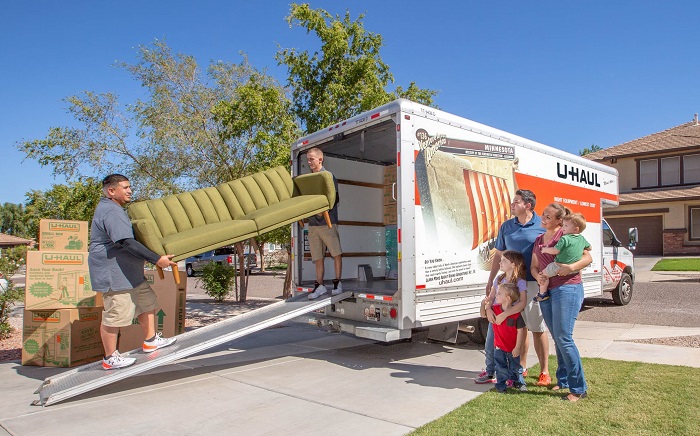Moving on your own isn’t an easy task, However, it does not have to be overly complicated. Here, we will go through the Top 10 Tips To Move By Yourself.
What matters when it comes to your house move is whether you hire a reputable moving company or do it on your own, without the assistance of professionals, and this decision will have the greatest impact on how you approach the entire process.
To determine which method is best suited to your case, consider factors such as cost, safety, and ease of moving, as well as the time and effort required. What it takes to move on your own – complete information that will assist you in making a wise decision and preparing for the DIY challenges that await you.
1. Moving yourself or Hiring Movers? – TOP 10 TIPS TO MOVE BY YOURSELF
Making a lot of decisions every day while getting ready to move out is stressful during this period. It is crucial to decide early on whether it is time for a self-move or better to trust a professional moving company to do it (almost) entirely on your behalf.
There are times when it’s clear which path to take. The best long-distance movers in the country should be hired if you’re moving to another part of the country that’s a long-distance away. Self-moving is also a viable option when moving a short distance away and you know you can count on your friends for assistance.
As a result, you may find yourself in a situation where deciding whether or not to hire movers or move on your own can be difficult. Indeed, this is a critical choice that will shape the rest of your relocation plans.
If you’re unsure about whether to hire a moving company or move on your own, here are some tips to help you decide.
Distance
This will have a major impact on whether you decide to move by yourself or hire moving services. Renting a vehicle and driving your belongings yourself is a viable option if you’re only moving a short distance, such as across town or to a new location within the same state.
In contrast, if the final destination is a long distance away, it is best to hire a cross-country moving company rather than risk driving a large moving vehicle across unfamiliar territory.
Specialty items
A DIY move may be a viable option if you don’t plan on moving any special items with you, so long as other moving conditions are favorable.
In the end, you must hire a professional moving company to transport your piano, grandfather clock, china cabinet, billiard table, hot tub, or any other piece of antique furniture. Remember that attempting to move a specialized item on your own will almost certainly result in disaster for both the item and yourself.
Time

It’s also important to consider the amount of time you have available when deciding whether or not to hire movers or move on your own.
Packing and moving services should be hired when you have a week or less to move. The problem is that you don’t know how to get things done when you have so little time.
It’s possible to plan a DIY move for the books if you have at least three weeks to plan the move.
Other important considerations include the availability of moving labor, the number of items you need to move, your prior move experience, and your ability to deal with stress when making a final decision.
2. Pack by yourself or hire professional packers? – TOP 10 TIPS TO MOVE BY YOURSELF
Once you’ve decided that a self-move is the best option for you, you’ll need to decide who will pack your belongings. The most time-consuming and critical part of a house move is surprisingly easy to outsource to a professional packer, even if you’re planning a DIY move.
However, how can you tell if hiring professional packers or doing the packing yourself is the better option?
The advantages of doing your packing
The advantages of packing your belongings for a house move are the following:
- It’s cheaper – Self-packing is the most cost-effective option because you won’t have to hire professional packers. You’ll have to buy all the packing supplies, but if you have enough time, most of them can be found for a very low price or even for free if they are in good condition.
- It’s more convenient – You’ll be able to pack on your terms if you do your packing. This means that you have a lot of leeway in terms of how you pack and how much time you have available. As a general rule, you should be able to control the speed of the packing.
- It’s more controlled. – When you pack your belongings, you have complete control over the entire process. Organizing and labeling your belongings before the move will save you time and effort when it comes time to unpack everything.
If you’re averse to having strangers handle your possessions, then you’ll have no choice but to pack up your home on your own.
The drawbacks of doing your packing
There are several drawbacks to doing all of the packings on your own. For starters, we’ll list these:
- It’s time-consuming. – Assuming that you’ll be done packing in a matter of hours is a mistake. Most of the time, you won’t even realize how much stuff you’ve accumulated over the years until you start sorting and packing it into cardboard boxes. You may not have the time to go through all of your belongings and pack them into boxes.
- It’s not easy – It’s not as simple as you think to pack for a move. When it comes to packing fragile and breakable items in your home, such as glasses, mirrors, china plates, vases, electronics, artwork, jewelry, etc., the packing process becomes more complicated because you have to ensure that those delicate items survive the move in one piece.
Ultimately, if you pack incorrectly, you may end up with more problems than you bargained for when you started.
3. How to pack by yourself

The cost of moving will be reduced because you won’t have to pay for professional packing services, and you’ll have more control over the packing process in general. So, you’ve made up your mind – you won’t be hiring professional packers to help you pack up your belongings.
A packing checklist, however, is the best way to ensure that your valuable possessions are packed safely and efficiently for the move, as it tells you what to pack and when, as well as how you should go about doing so.
When you’re doing your packing, follow these guidelines:
- Inventory your possessions – Creating an inventory of your home is the first step in assessing the scope of the packing and moving task ahead of time. As you go through each room, make a list of everything you own, including the type of item you have and its current condition, among other details.
- Sort out your items – Packing up everything you own and moving it to the new house is a bad idea. Why? It’s as simple as the fact that none of those items will be required.
As soon as you’ve completed the inventory of your home, it’s time to divide your belongings into three categories: 1) things to be thrown away, 2) things to be sold/given away, and 3) things that you’ll need to pack for your move. - Gather packing supplies. – You’ll be responsible for securing all of the packing supplies you’ll need, including cardboard boxes, bubble wrap, packing tape, and permanent markers. That’s when it’s time to focus on cardboard boxes because they account for the bulk of your moving costs.
4. How to get your friends to help you relocate.
If you’re moving on your own, you’ll need to enlist the help of trusted friends and family members. That being said, even if you find the time to pack everything up and move without the assistance of your friends, you’ll still need their physical strength when you arrive at your new home.
Your final decision on whether to move yourself or hire a moving company will depend on the likelihood that you will be able to secure the assistance you so desperately need. A full-service moving company or just moving labor may be the only option if you know you can’t count on your friends for help (for whatever reason).
To ask for help moving, you should know the following:
- Do it early – The sooner you get in touch with your best friends, the more likely it is that they will say yes. Assume they’re in your shoes and ask yourself, “Would you like it if someone asked you to help them move?” Not at all. To show respect for your friends’ previous plans and commitments, you’ll need to do so.
- Ask them in person. – Using social media platforms like Facebook or Twitter to solicit moving assistance can be very alluring. It’s much more convenient, and you won’t have to face your friends directly if they say no. However, the preferred alternative is to call your close friends and ask them to do it over the phone if that isn’t possible. When it comes to such serious matters, the impersonal nature of social media platforms makes them unsuitable.
- Be honest with them. – When you ask your best friends to help you pack and move, be honest with them. Even if you risk being rejected, tell them in advance if there will be a lot of heavy lifting. That’s preferable to having to face your dissatisfied or even angry friends on the day of your move. It’s not worth the risk of damaging some of your friendships if most of them say no because you still have the option of hiring professional moving labor.
- BE ready for their arrival. – Think of it as a favor that you’re asking of your friends, so you should be prepared when they arrive. Depending on the situation, your level of preparedness can range from securing the necessary packing supplies to getting the necessary moving equipment and a moving vehicle when you need assistance moving and loading heavy items. Preparation is the best way to show your friends that you appreciate their time and effort.
5. Guide to moving large items
Unless you hire a moving company, you’ll have to find a way to pack and move your furniture if you want to bring any of it with you. Of course, you’ll need the assistance of family members or friends to ensure your safety and to build up your physical strength.
Moving heavy furniture by yourself? Here are some pointers to keep in mind:
Make sure you have the right moving equipment for your furniture.
The only way to ensure a secure move when moving furniture on your own is to have two specific pieces of moving equipment at your disposal.
- Furniture dolly. – With a furniture dolly, you’ll be able to move heavy furniture out of your house with minimal effort and without damaging the floors, walls, or doors.
- Furniture sliders. – Large and heavy furniture can be moved across the room with ease thanks to small pieces of hard plastic or rubber. The best sliders can be purchased from a moving company, a home improvement store, or online.
Assemble each piece of furniture one by one.
When moving large pieces of furniture on your own, disassembly is a crucial step to take. Remove any parts that can be separated, such as the arms, legs, shelves, and doors, and pack them separately in a separate container or bag.
Assembling and disassembling your furniture before moving reduces the overall weight, simplifies packing, and ensures that all disassembled furniture items can safely pass through all doorways and hallways.
Protect the furniture
One of the most important things to remember when moving furniture by yourself is to keep it safe at all times. That’s why you’ll need to take extra care when transporting the pieces.
- With duct tape, secure all of the moving blankets to the wooden surfaces you’re working with To avoid damaging your furniture, never apply packing tape directly to it.
- Wrap the most delicate parts of your furniture in packing paper first, and then use bubble wrap to protect them from the elements.
- The corners of furniture can be further protected by attaching corrugated cardboard.
- Use twine to secure all movable but non-detachable elements during the move.
6. How to rent a moving truck
Moving on your own necessitates carefully selecting the moving vehicle you will use to transport your belongings to your new residence. In the end, the cheapest option will be for you to transport your belongings in your truck. You may have to rent a truck from a truck rental company and drive it further than just across town in most DIY moving cases, however.
When renting a moving truck, keep in mind that it will be your biggest self-moving expense, so do your best to keep those costs down.
Moving trucks come in all shapes and sizes.
Choosing the right size moving truck for your house move is critical. Picking an automobile that doesn’t have enough room for all of your belongings means that you’ll either have to make multiple trips between the two homes or rent a larger truck to move. Choosing a truck with too much storage space is also not ideal because you will be forced to pay for space that you will not use.
When moving on your own, you should be able to rent the following types of moving trucks:
- Pickup truck – Small loads or partial moves are no problem for this method.
- Cargo van – Studio apartment, partial move, and college move-in/move-out are all uses for this tool.
- 10-12 ft. truck – When relocating from a studio or a one-bedroom apartment, small moving trucks are ideal.
- 14-17 ft. truck. – The most popular moving vehicle is a medium-sized moving truck because of its excellent price-to-usefulness ratio. If you’re moving from a one-bedroom apartment, a small house, or an office, renting a medium-sized truck is an excellent option.
- 20-26 ft. truck. – Moving out of a large house or apartment with 3-4 bedrooms calls for one of the largest moving trucks available for hire. Diesel is the fuel of choice for most large-capacity moving vehicles.
7. How to pack a truck for a move

You’ll need to learn how to properly load your moving truck once you’ve found a vehicle that meets your needs. It may not appear difficult to load a moving truck, but several things can go wrong, potentially leading to a variety of issues that could jeopardize the safety of the entire DIY relocation mission.
Choosing the right type and size of moving vehicle, as well as the necessary moving equipment and tools (a moving dolly, furniture straps, moving blankets), is essential before you begin loading a truck. Also, make sure the path to the moving vehicle is clear of any obstacles, as well as enlist the help of trustworthy friends who can provide the manpower you need.
8. To cross the country in a moving truck
A self-move is one where you don’t use the services of a professional moving company, and that means you’ll have to drive the truck yourself from your old location. Once you’ve properly loaded the moving truck, it’s time to settle in and begin the (dreaded) relocation process.
Truck driving across the state is not an easy task. With your valuable possessions in the van and possibly even members of your family in the truck, you’ll soon realize how much responsibility you’ve taken on.
- Take a close look at the truck before renting it from a reputable rental agency. After inspecting the truck’s interior, check the tires, signals, and lights for damage. Get familiar with the truck’s controls after that, which should be fairly simple.
- Check if all of the items in the truck’s cargo area have been properly secured before you begin your journey. If the truck walls aren’t properly fastened, your more delicate items could be damaged by sudden braking.
- Make sure that you don’t accelerate too quickly because it will eat up more fuel (costing you money) and may cause your backseat cargo to shift unnecessarily. Instead, start slowly and build up to the speed you desire.
- Remember that trucks are much heavier than cars and can’t come to a complete stop as quickly. When driving in bad weather (rain, snow, ice), you should apply the brakes early and avoid slamming the brakes, as that could result in you losing control of the moving vehicle.
- When driving a moving van across the country, keep a safe distance from other vehicles. Avoid tailgating by driving twice as far away from the vehicles ahead as you normally would.
- When changing lanes or merging, be extra cautious because there is no center rearview mirror. Keep to the right lane on the highway and allow faster traffic to pass you by.
9. DIY moving mistakes to avoid
Making a mistake is never fun… It’s not uncommon for DIY moves to go awry if any mistakes are made during the process.
Even though some mistakes are minor and you wish you hadn’t made them in the first place, they cannot harm your budget, time management, or nervous system as much as the serious blunders you should avoid at all costs. The good news is that not all moving mistakes have serious consequences.
Moving on your own is difficult at any time, but it’s especially difficult the first time you do it. Here are some of the most common mistakes people make when moving on their own and how to avoid them.
You assume self-moves are always cheaper than hiring movers
It’s dangerous to assume that moving by yourself is the cheapest option for moving to a new home. Keep in mind that when moving to a new home, DIY moves can be more cost-effective than hiring a moving company.
- short-distance relocation
- having dependable friends who can assist you with the heavy lifting
- having previous experience in moving house
- Relocating a small number of belongings without any specialized items.
Even if you decide to move on your own, don’t forget to factor in all of the additional costs that come with it: packing supplies and equipment rental or purchase; additional moving insurance; road tolls and taxes; renting a moving truck and paying for fuel; and so on.
When moving on your own, you assume that time is on your side.
When moving on your own, one of the most common mistakes is to underestimate how long it will take to complete the most important tasks before the move-out date. The first sign that you’re on the wrong path is if you find yourself thinking that moving day is a long time away.
If you put off packing for a long time or start the process in the wrong order, you could end up with a truly chaotic moving day.
Moving on your own is a time-consuming endeavor, so your most powerful weapon should be a moving checklist.
You rent the wrong moving truck
If you’re moving by yourself, you’re more than likely going to make a big mistake if you rent the wrong truck.
Choosing a moving vehicle with less storage space because it is cheaper can put you at risk of not being able to fit all of your belongings in it.
If you go with a larger truck, you’ll be paying for storage space you won’t use and driving a larger-than-necessary vehicle that will increase the risk of an accident during your move.
Ask the experts at the truck rental companies to help you select the best vehicle for your moving needs.
10. The biggest risks when moving by yourself
As far as moving is concerned, hiring a full-service moving company is the best option. However, because each house move is different, you may still choose to move without the help of a moving company.
There are many risks and dangers associated with a DIY move, so it is important to be aware of them to ensure that everything goes as smoothly as possible, especially on the day of the move itself.
Make sure you’re ready for what’s to come! If you’re moving on your own, here are the biggest dangers you face:
Damaged items
When moving on your own, you run the risk of damaging or breaking some of your most precious possessions due to carelessness in packing, incorrect lifting, and carrying, or inadequate protection in the moving truck.
There should be no harm done if a box of clothes or books is dropped accidentally. If you drop a container full of highly-breakable items, you’ll need to be prepared to pick up the pieces.
You’ll need to know how to protect your prized possessions throughout the moving process if you want to avoid major headaches, so it’s important to know how to pack delicate items.
Property damage
Property damage is a serious risk to consider when planning a self-move, even if you’re only concerned about keeping your valuables safe.
To avoid damaging the floors, chipping or denting walls and door frames, or even breaking a banister, you need the right moving equipment—a moving dolly with rubber wheels and high-quality furniture sliders.
Consider placing blankets over high-risk areas, such as doorways and door frames, during a self-move to avoid damaging your current home or the new one you’ll be moving into during a self-move.
Personal injuries
People getting hurt while moving is the worst possible outcome of a house move. From back injuries that result from improper lifting techniques to muscle strains, contusions, and cramping, there is a wide range of injuries that can occur during moving.
Preventing moving day injuries is better than treating them later:
- move with caution and with the proper tools.
- dress and footwear that is appropriate,
- ask friends to assist you in lifting and moving heavy objects
- lift with proper technique, and most importantly: lift with proper technique.
- Before attempting a task that seems potentially hazardous, take the time to think it through and make a plan.
Moving on your own is a lot more difficult than you might think. Other serious risks of self-moving include wasting time and money because you don’t know what to do next (follow a moving checklist to manage your time) (create a moving budget to control your expenses).



